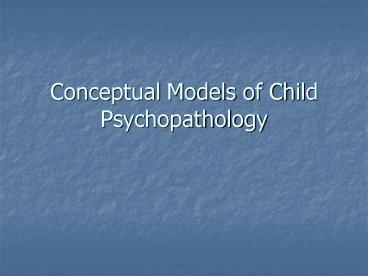Conceptual Models of Child Psychopathology - PowerPoint PPT Presentation
1 / 24
Title:
Conceptual Models of Child Psychopathology
Description:
Problems with models. May prevent us from seeing important aspects of a problem ... Biological Model ... Ecological models ... – PowerPoint PPT presentation
Number of Views:269
Avg rating:3.0/5.0
Title: Conceptual Models of Child Psychopathology
1
Conceptual Models of Child Psychopathology
2
Models and theories
- Set of principles used to analyze or explain a
set of phenomena - Example temper tantrums
3
Why use models/theories?
- Intuitive scientists
- Effective and efficient
- Testable hypotheses
4
Problems with models
- May prevent us from seeing important aspects of a
problem - Will direct the way choose to treat the problem
- Examples
5
How to judge a theory
- Comprehensiveness
- Parsimony
- Empirical validity
- Testability
- Usefulness
6
Developmental Considerations (cont.)
- Developmental Psychopathology Perspective
- stresses the importance of developmental
processes - viewed as a macroparadigm
- to understand maladaptive behavior, must know
normative behavior
7
Developmental Psychopathology Perspective (cont.)
- Figure 2.3 Developmental psychopathology as a
macroparadigm. Based on Achenback, 1990).
8
Biological Model
- Interested in underlying organic pathology
considers brain and nervous system functions as
underlying causes of psychological disorders - Genes produce a tendency
- Temperament activity, emotionality,
sociability, aggressive/impulsive - Toxins/drugs
- Physical illness/trauma
- Neurotransmitters
9
(No Transcript)
10
Biological Models (cont.)
- Neurobiological Contributions
- different areas of the brain regulate different
functions and behaviors - the endocrine system--hormones
- especially implicated in health- and
stress-related disorders
11
Biological Models (cont.)
- Neural Plasticity and the Role of Experience
- maturation of the brain is an organized,
hierarchical process - consequences of traumatic experience
12
Benefits and drawbacks of medical model
- Strengths
- Application for prevention and treatment
- Reduces stigma
- Takes blame off of parents
- Drawbacks
- Only addresses symptoms
- Fails to address environmental factors
- Side effects of drugs
13
Psychodynamic Models
- Dominated thinking for a long time
- Not all that appropriate for kids
- Not motivated/self-referred
- Introspection limited
- Requires stable personality structure
- Doesnt address environmental forces
14
Psychological Perspectives
- Emotional Influences
- emotions tell us what to pay attention to and
provide motivation for action - children may have difficulties in emotion
reactivity or emotion regulation - temperament shapes the childs approach to the
environment and vice versa
15
Psychological Perspectives (cont.)
- Behavioral and Learning Influences
- Applied Behavior Analysis --antecedents and
consequences - classical conditioning
- social learning
- social cognition - how children think about
themselves and others
16
Importance of Learning Perspectives
- Optimistic about change
- Simple, straightforward
- Downplays previous life history
- Leads to treatment interventions
- Forces us to be concrete
- Strong record keeping
- Active involvement for parents and teachers
- Scientific base
- efficient
17
Learning perspective problems
- Tries to explain too much
- Doesnt address developmental issues well
- Might ignore cognitions
18
Lepper et al.
- Purpose test of overjustification hypothesis
persons intrinsic interest may decrease if given
it provides a means to achieving an extrinsic
goal - This effect is predicted for any situation where
extrinsic attribution becomes present when
intrinsic interest was only prior attribution for
engaging in the behavior
19
Lepper et al.
- IV reward condition/experimenter intervention
- Manipulation reward for engaging in a drawing
activity (expected, unexpected, and none) - DV time spent on drawing activity after the
experimental procedure - Results
- Children in expected reward condition spent less
time drawing than children in the other conditions
20
Cognitive-Behavioral Approaches
- Includes thoughts/internal experiences
- Attributions
- Appraisals
- Expectancies
- Examples
- Problem solving training
- Impulse control training
- Perspective taking
- Limitations
21
Family, Social, and Cultural Influences
- Ecological models
- describe the childs environment as a series of
nested and interconnected structures
22
Family, Social, and Cultural Influences (cont.)
Figure 2.8 An ecological model of environmental
influences.
23
Family and Social Influences (cont.)
- Evolution and Attachment
- attachment theory -- evolving child-caregiver
relationship, - helps the child to regulate behavior and
emotions, especially in conditions of threat or
stress - 4 patterns of attachment, types of internal
working models - Secure
- anxious-avoidant
- anxious-resistant
- disorganized
24
Family and Social Influences (cont.)
- The Family and Peer Context
- study of individual factors and the study of the
childs context are mutually compatible and
beneficial to both theory and intervention - family system theorists study childrens behavior
in relation to other family members































